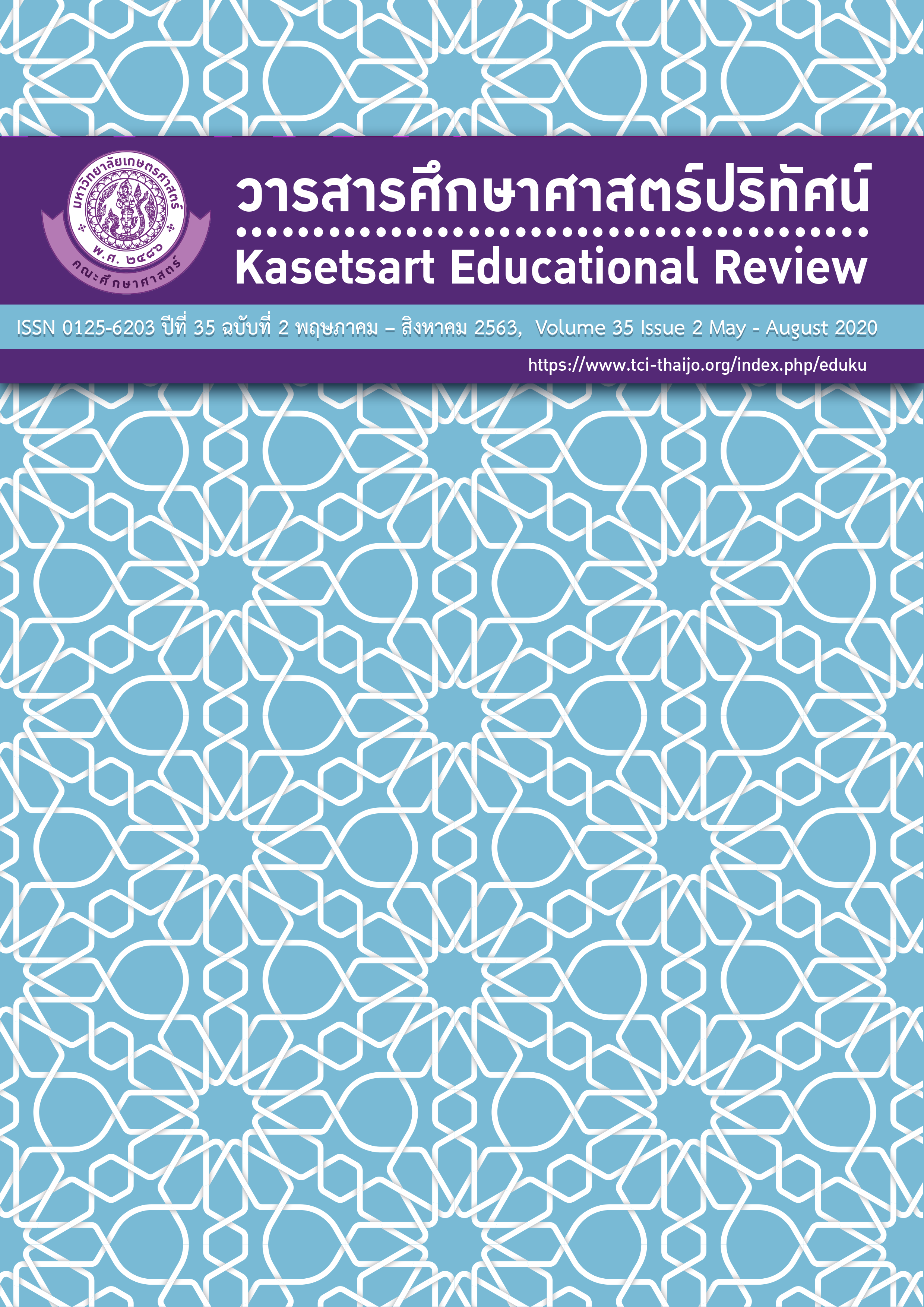ผลการจัดการเรียนรู้แบบสืบเสาะหาความรู้ร่วมกับการใช้เทคนิคการเขียนทางวิทยาศาสตร์ (SWH) เรื่อง อัตราการเกิดปฏิกิริยาเคมี ที่มีต่อผลสัมฤทธิ์ทางการเรียนวิทยาศาสตร์และความสามารถในการสร้างคำอธิบายเชิงวิทยาศาสตร์ของนักเรียนชั้นมัธยมศึกษาปีที่ 5 โรงเรียนขนาดเล็ก สังกัดสหวิทยาเขตชุมพร 2 จังหวัดชุมพร
คำสำคัญ:
การจัดการเรียนรู้แบบสืบเสาะหาความรู้, เทคนิคการเขียนทางวิทยาศาสตร์, ผลสัมฤทธิ์ทางการเรียน, การสร้างคำอธิบายเชิงวิทยาศาสตร์บทคัดย่อ
การวิจัยครั้งนี้มีวัตถุประสงค์เพื่อ 1) เปรียบเทียบผลสัมฤทธิ์ทางการเรียนวิทยาศาสตร์ของนักเรียนชั้นมัธยมศึกษาปีที่ 5 ที่เรียนโดยการจัดการเรียนรู้แบบสืบเสาะหาความรู้ร่วมกับการใช้เทคนิคการเขียนทางวิทยาศาสตร์ (SWH) เรื่อง อัตราการเกิดปฏิกิริยาเคมี หลังเรียนกับเกณฑ์ร้อยละ 70 2) เปรียบเทียบความสามารถในการสร้างคำอธิบายเชิงวิทยาศาสตร์ของนักเรียนชั้นมัธยมศึกษาปีที่ 5 ที่เรียนโดยการจัดการเรียนรู้แบบดังกล่าวระหว่างก่อนเรียนและหลังเรียน และ 3) ศึกษาระดับความสามารถในการสร้างคำอธิบายเชิงวิทยาศาสตร์ของนักเรียนชั้นมัธยมศึกษาปีที่ 5 ที่เรียนโดยการจัดการเรียนรู้แบบดังกล่าว
กลุ่มตัวอย่างที่ใช้ในการวิจัย ได้แก่ นักเรียนชั้นมัธยมศึกษาปีที่ 5 ปีการศึกษา 2561 โรงเรียนพะโต๊ะวิทยา จังหวัดชุมพร จำนวน 31 คน ได้มาจากการสุ่มแบบกลุ่ม ใช้ห้องเรียนเป็นหน่วยสุ่ม เครื่องมือที่ใช้ในการวิจัยครั้งนี้ ได้แก่ 1) แผนการจัดการเรียนรู้แบบสืบเสาะหาความรู้ร่วมกับเทคนิคการเขียนทางวิทยาศาสตร์ (SWH) 2) แบบทดสอบวัดผลสัมฤทธิ์ทางการเรียนวิทยาศาสตร์ และ 3) แบบวัดความสามารถในการสร้างคำอธิบายเชิงวิทยาศาสตร์ สถิติที่ใช้ในการวิเคราะห์ข้อมูล ได้แก่ ค่าเฉลี่ย ส่วนเบี่ยงเบนมาตรฐาน ร้อยละ การทดสอบค่าที และการวิเคราะห์เนื้อหา
ผลการวิจัยปรากฏว่า 1) ผลสัมฤทธิ์ทางการเรียนวิทยาศาสตร์ของนักเรียนชั้นมัธยมศึกษาปีที่ 5 ที่เรียนโดยการจัดการเรียนรู้แบบดังกล่าว หลังเรียน สูงกว่าเกณฑ์ร้อยละ 70 อย่างมีนัยสำคัญทางสถิติที่ระดับ .05 2) ความสามารถในการสร้างคำอธิบายเชิงวิทยาศาสตร์ของนักเรียนชั้นมัธยมศึกษาปีที่ 5 ที่เรียนโดยการจัดการเรียนรู้แบบดังกล่าว หลังเรียนสูงกว่าก่อนเรียนอย่างมีนัยสำคัญทางสถิติที่ระดับ .05 และ 3) ระดับความสามารถในการสร้างคำอธิบายเชิงวิทยาศาสตร์ของนักเรียนชั้นมัธยมศึกษาปีที่ 5 ที่เรียนโดยการจัดการเรียนรู้แบบสืบเสาะหาความรู้ร่วมกับการใช้เทคนิคการเขียนทางวิทยาศาสตร์ (SWH) มีคะแนนเฉลี่ยอยู่ที่ 15.97 ซึ่งมีความสามารถในการสร้างคำอธิบายเชิงวิทยาศาสตร์อยู่ในระดับดี
เอกสารอ้างอิง
Anuworrachai, S. (2014). Science Learning Management by Using the Scientific Explanation. STOU Education Journal. 7 (2), 1-14.
Boonjuthasirikul, S. (2018). The Study of Grade 11 Student’ Ability in Making Scientific Explanation on Chemical reaction rate by Using Science Writing Heuristic(SWH) Approach. Degree Thesis in Science Education, Khon Kaen University. (in Thai)
Chamrat, S. (2017). Foundations, Methodologies, and Nature of Science Education. Nonthaburi: Department of Education Sukhothai Thammathirat Open University. (in Thai)
Chowakeratipong, N. (2019). Enhancing the Ability in Constructing Scientific Explanations of Learners by Using the Inquiry Teaching Method. STOU Education Journal. 12 (1), 40-54.
Dechsri, P. (2014). Provision of Learning Experiences in Sciences. Nonthaburi: Department of Education Sukhothai Thammathirat Open University. (in Thai)
Hand, B. M. (2008) Science Inquiry, Argument and Language: A Case for the Science Writing Heuristic. Retrieve from https://brill.com/view/title/37522?lang=en.
Khuanpuck, A. (2014). Effects of Using 5E Learning Cycle Cooperate with Song on Science Learning Achievement and Positive Learning Atmosphere of Lower Secondary School students, Bangkok Metropolitan. Degree Thesis in Science Education, Chulalongkorn University. (in Thai)
Ladachart, L. and Yuenyong, C. (2015). What Thai Science Teachers Should Learn From The Programme for International Student Assessment. Parichart Journal, 28 (2), 108-134.
McNeill, K. L., and Krajcik, J. (2008). Scientific explanations: Characterizing and evaluating the effects of teachers' instructional practices on student learning. Journal of Research in Science Teaching, 45(1), 53-78.
McNeill, K. L., Lizotte, D. J., Krajcik, J., and Marx, R. W. (2006). Supporting students' Construction of scientific explanations by fading scaffolds in instructional materials. The Journal of the Learning Sciences, 15(2), 153-191.
Ministry of Education. (2008). Basic Education Curriculum 2008 (Revised Edition 2018). Bangkok: Kurusapa Printing Ladphrao. (in Thai).
Nam, J., Chol, A. and Hand, B. M. (2010). Implementation of the science writing heuristic (SWH) approach in 8thgrade science classrooms. International Journal of Science and Mathematics Education, 9, 1111-1133.
National Institute of Education. (2013). Report of the National Basic Educational Testing (O-Net) for the academic year 2009-2011. Retrieved from https://www.niets.or.th/th.
Office of the Education Council. (2009). Report on Problems and Solutions for teaching and Learning that affect the quality of Learners development in basic education. Bangkok: V.C.T. communication.
Osborne, J. F., and Patterson, A. (2011). Scientific Argument and Explanation: A Necessary Distinction?. Science Education, 95(4), 627-638.
Poock, Burke, K. A., and Hand, B. M. (2007). Using the Science Writing Heuristic in the General Chemistry Laboratory To Improve Students' Academic Performance. Journal of Chemical Education, 84 (8), 1371-1379.
Putti, A. (2011). High School Students' Attitudes and Beliefs on Using the Science Writing Heuristic in an Advanced Placement Chemistry Class. Journal of Chemical Education, 88 (4), 516-521.
Rudd, J. A., Greenbowe, T. J., and Hand, B. M. (2007). Using the Science Writing Heuristic To Improve Students' Understanding of General Equilibrium. Journal of Chemical Education, 84 (12), 2007-2011.
Ruengtham, T. (2016). Science Writing Heuristic. IPST Magazine, 45 (203), 7-13.
Saengyoo, R. (2013). Effects of 5E Learning Cycle with Questioning Technique Based on Osborn’s Approach on Integrated Science Process skills and Science Learning Achievment of Lower Secondary School students. Degree Thesis in Science Education, Chulalongkorn University. (in Thai)
Sapasuntikul, K. (2015). Effects of Chemistry Teaching Strategy using the Predict-Observe-Explain sequence on ability in Scientific explanation making and Rationality of Tenth grade students. Degree Thesis in Science Education, Chulalongkorn University. (in Thai)
The Institute for the Promotion of Teaching Science and Technology. (2001). Handbook of Science Management. Bangkok: Kurusapa Printing Ladphrao. (in Thai).
_________. (2018). PISA 2015 Assessment Reading Science and Mathematics Excellence and equality in education. Bangkok: Success Publication.
Woody, A. I. (2015). Re-orienting discussions of scientific explanation: A functional perspective. Studies in History and Philosophy of Science Part A, 52, 79-87.
ดาวน์โหลด
เผยแพร่แล้ว
ฉบับ
ประเภทบทความ
สัญญาอนุญาต
บทความทุกบทความเป็นลิขสิทธิ์ของวารสารคณะศึกษาศาสตร์ มหาวิทยาลัยเกษตรศาสตร์ วิทยาเขตบางเขน
วารสารศึกษาศาสตร์ปริทัศน์ (Kasetsart Educational Review)






